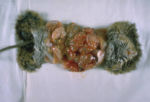Difference between revisions of "Echinococcus multilocularis"
m (moved Echinococcus to Echinococcus multilocularis) |
|
(No difference)
| |
Revision as of 14:47, 7 June 2010
| This article is still under construction. |
Alveolar Hydatid Disease (E. multilocularis)
This parasite does not occur in the UK. It is largely restricted to forest areas of central Europe (including Switzerland where urban foxes are also infected) and North America. It is a significant public health problem and is spreading across Europe, where 12 countries are now affected compared with four in the 1980’s. The metacestode is the alveolar (or multilocular) cyst. Human infections are particularly dangerous as daughter cysts bud off externally as well as internally from the germinal layer so that the cyst rapidly infiltrates the liver like an invasive tumour, and is inoperable. Dogs, and to a lesser extent cats, can become infected with the adult tapeworm, but the main epidemiological cycle involves the fox as the final host and microtine rodents (particularly voles) as intermediate hosts. The latter have a very short life-span – hence the rapid growth-rate of the alveolar cyst in intermediate hosts, including humans. The anti-rabies campaign in Europe has led to a large increase in the number of foxes and, consequently, of infected rodents.
Echinococcus granulosus in Peritoneal Cavity Parasitic and muscles
- Echinococcus granulosus in hydatid disease of lungs
